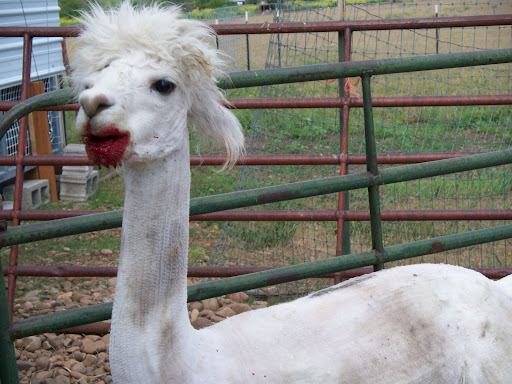

I met "Alpaca Joe"* a few years back at a spinning class. It wasn't surprising to me that an alpaca rancher would want to learn to spin; with all the silky fiber at your disposal, how could you not. What was surprising was that "Joe" was, well, a guy, and I have met so few male spinners that they must be very few and far between. During the class, as Joe revealed his avocation as an alpaca breeder, I commented on how very cool it would be to visit an alpaca ranch. To my delight, Joe extended an invite to visit at my leisure. I thought it might seem impolite to ask if I could just follow him home, so I waited an acceptable few days to ask if I could "drop by." Turns out that "dropping by" was an 80 mile ride each way up into the mountains. Joe and his small herd live on a parcel of land nestled high up where the spring comes a month later than it does in the valley. Joe kept not only alpaca, but a good sized garden and an impressive variety of chickens. For a girl from the suburbs, it wasn't just interesting. It was lovely.
Now, let me digress for just a moment. I learned to spin on alpaca fiber. My knitting preference has always been alpaca, and when I decided to learn to spin it was so that I could fondle the soft fluffy fiber in a more elemental way. My fascination with all things alpaca precluded hearing the voices that said that alpaca was a fussy fiber, best left for a spinner with a healthy dose of experience. My innate love for the stuff was in no way diminished during the learning curve. So a chance to see my favorite fiber on the hoof was not something I could pass up.
I've made several visits since then, and with each visit I learn a little more about these amazing creatures. Last year my husband and I volunteered to help on shearing day, but our timing was off and we didn't manage to get there. But this year there was nothing that could keep me from being part of the annual ritual and dance that separates the fiber from the animal.
And it was something.
Shearing starts early in the day; 8 a.m. in this case, while the air is still cool. I didn't know that shearing would be hot and dirty work. (Well, I expected dirty, having watched alpacas in their native habitat roll around in the dirt whenever possible. But I forgot that under all that fleece is a very warmblooded critter.) I've seen sheep sheared, and it's very physical. Usually the shearer (a truly underappreciated vocation) handles the sheep himself. Alpaca, though not really big, are taller and more gangly than most sheep, and more than a handful for one person. So the shearer binds the animal's hands and feet and, with help, the animal is stretched out with it's feet in front and in back. The shearer has no trouble running the clipper over the animal to remove the pelt.

Belly fur, too coarse and matted to be of use, is sent to the compost heap. Then the prime blanket is carefully removed from the animals back and sides and set aside to be skirted. The upper legs and neck are trimmed and set aside as "seconds." Finally, any additional areas, such as the face, tail and lower legs, are trimmed. It takes several people, dancing around one another, to efficiently shear alpacas and their larger cousins, llamas. But the whole thing, if well coordinated, takes less than 15 minutes. A handful of us sheared 18 alpacas and three llamas in just about five hours.
Once shorn, alpacas appear to be slightly embarrassed by their significantly smaller size, But they are certainly cooler without the fur coat!


When alpaca are sheared, it is usual for their hooves to be trimmed and their teeth to be filed down so that they don't hurt each other if they fight. Though not painful, sometimes the animals jerk or pull away. Ever been to the dentist and had a little "pink in the sink" when you were done? Same thing happens from time to time during shearing. This is Doc, and it isn't near as bad as it looks. He complained for five minutes and then seamed unaffected. By the way, his "before" picture is the first one at the top of the page. Doesn't look the same, does he?

At the end of the day, (well, it was only midday, but you know what I mean) I was exhausted, and I had the easiest of jobs! I was assigned to the skirting table, which means I helped remove the blanket as it was clipped, carried it to the skirting table, separated as much guard hair, 2nd clips and debris as possible in the 10 minutes it took to finish clipping that animal and get the next one set to clip, and bag up the fleece and move it to temporary storage. (And my apologies to whoever must prepare the fleece for processing. I promise to do better next time.)
All in all it was a fascinating experience. In payment for my labor (and that of my husband) Alpaca Joe allowed me to pick a fleece for my very own. He also gave me the blanket from Larry, the Guard Llama. Last year I would have picked the fleece based on color; this year, because I was more experienced, I picked based on the fineness of the fleece, and Ace's blanket came home with me. Next time I'll share with you the pros and cons of choosing fleece from the first shearing of a one year old alpaca.
*
Names have been changed to protect the innocent.
